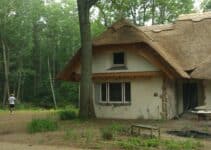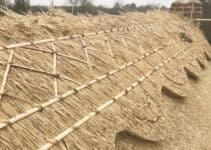Although thatched roofs are desirable from an appearance perspective, it’s fair to wonder whether they’re more of a risk than tiled roofs.
So, are thatched roofs a fire hazard? Thatched roofs are a fire hazard because they’re made of flammable materials. However, one report found that they’re statistically no more likely to catch fire than a tile roof, provided you’re careful. Once they do catch fire, though, they’ll burn pretty quickly.
In this article, we’ll look in more detail at why thatched roofs are a fire hazard and what you can do to minimise the risks.
Are Thatched Roofs a Fire Hazard?
If you’ve ever looked at a thatched roof, you can probably already gather that it’s more of a fire hazard than a tile roof. This is because the building material is organic – reed or straw – which is far more flammable than stone or clay.
But defining something as a fire hazard doesn’t just consider its ability to catch fire. We must also think about what happens if (or when) a spark causes something to burn.
Specifically, a fire in a thatched roof will spread very quickly for two reasons. First, there’s the organic material, which is highly flammable.
Then, there’s the fact that thatch insulates by trapping air between the reeds or straw. As you probably know, fire needs air to burn.
Fire will spread more easily from thatch to the surrounding structure, too. Thatch will burn at a temperature of around 200C, whereas brick and tile have a melting point of more than 1,500C.
This means that the roof’s wooden supports will catch fire long before the roof material.
However, thatch essentially serves as kindling for the wooden supports. Wood can catch fire at 400C, so once thatch gets burning, it won’t take long for the rest of the roof to catch fire.
Finally, there’s the issue of putting the fire out. Thatching materials are designed to repel water, whether through treatment, design, or installation.
Unsurprisingly, this is bad news when we want to put out a fire, particularly if it’s burning below the roof’s surface.
The bottom line is that thatched roofs are a fire hazard if you’re not careful about what you burn near them.
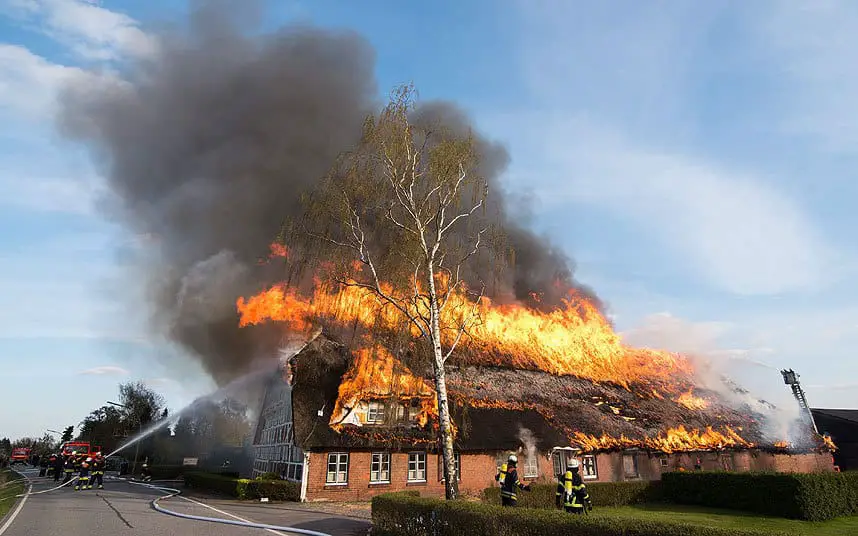
Are Thatched Roofs More Likely to Catch Fire?
A thatched roof is no more likely to catch fire than a tile or slate roof. This is because the causes of the fires are the same regardless of what kind of roof you have on your home.
To understand this better, we need to be more careful with our terminology.
When we say “catch fire”, we’re not talking about the ability to burn. As we established above, a thatched roof will burn far more easily than tile once the fire gets going.
However, catching fire refers to the ability for a spark to ignite, which is statistically the same for thatched and tiled roofs.
But why is this? Simply put, it’s because the causes of fires are the same in pretty much all homes. They include:
· Chimney and wood burner issues
· Electrical malfunctions
· Lightening
· Cigarettes or unmonitored fire sources
As such, it’s incorrect to assume thatch is more likely to catch fire than tile because the causes and risks are the same regardless of what your house is made from.
The only real difference is weather conditions. One report found that thatched roof fires were more likely after a period of dry weather, as this made the thatch more flammable.
So, if you’re concerned about the flammable nature of a thatched roof, don’t be. The easiest way to control this is with prevention, including fireproofing your roof and proper use of a wood burning stove.
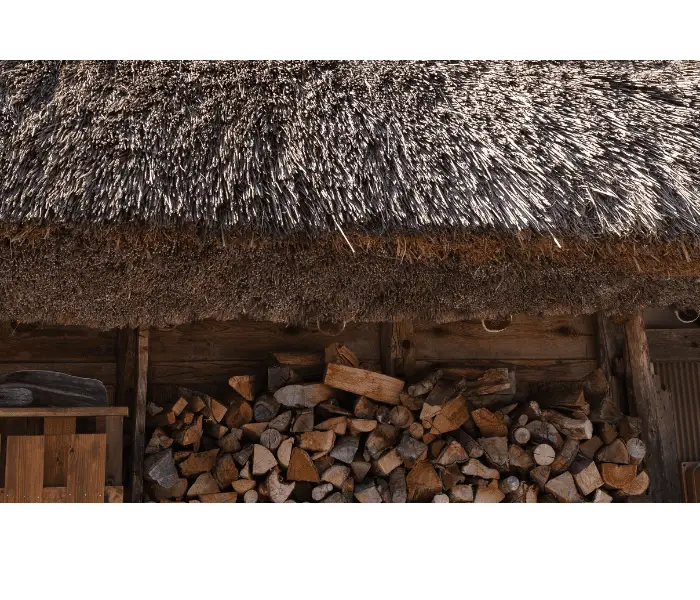
Bonfires and Thatch
Bonfires are something that thatched roof owners would understandably be concerned about, but the outlook isn’t as bad as you might think.
First, 90% of thatched roof fires are caused by chimney issues, meaning bonfires fall into the remaining 10%. Considering this covers literally every other cause of fire, it’s a low statistic.
Plus, the chances of a stray spark igniting your whole roof are fairly low. Conditions have to be perfect for a single spark to do damage, as it’ll more often just burn out.
Think about burning an open fire with a carpet on the hearth. Sure, sparks will burn holes in the carpet, but it’s not likely that it’ll go up in flames.
We should also factor in the weather because it’s a vital component of fire conditions. Statistically, most bonfires happen in the autumn (that’s when Bonfire Night is, after all).
The weather is wetter at this time of year, meaning a stray spark won’t have much fuel in a damp thatched roof.
Of course, this doesn’t apply to summer bonfires, but they’re just as easy to deal with. Although embers can travel up to 5 miles in bush fires, they need perfect conditions to do so.
Just make sure you don’t light a bonfire anywhere near your home (20 metres should be the absolute minimum). Better yet, don’t light a bonfire during dry weather, as it could be a risk for more than just your home.
How Do You Fireproof a Thatched Roof?
Luckily, advances in fireproofing technology mean there’s now plenty we can do to reduce the risks of a fire in a thatched roof. Here’s a brief overview of some of the most common options.
Proper Log Burning Stove Care
Granted, this isn’t a fireproofing tip per se, but log burners cause 90% of thatched roof fires. But you can have a wood burner in a thatched cottage, so we won’t focus on it too much here.
The bottom line is that you should clean the chimney and stove regularly, and line the flue inside the roof. Doing so minimises the chance of a fire starting in the first place, which reduces the need for fireproofing materials (although they’re still a good idea).
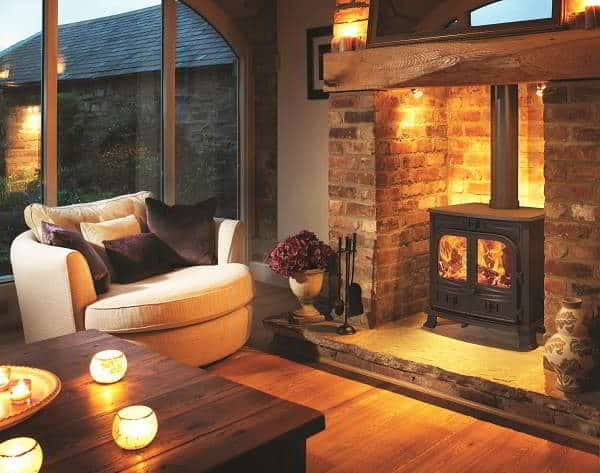
Thatch Batts
Thatch batts are non-combustible tiles that you install underneath your thatched roof. They’re made from mineral wool fibre, also known as stone wool or rock wool.
The fibres are bonded together with resin to form flexible slabs.
Mineral wool looks very similar to fibreglass and it’s made in the same way. Essentially, rock or minerals are heated until they melt and then spun into thin fibres.
These are then bonded together into a sheet to form mineral wool.
Batts are pretty amazing fire insulation. They can withstand temperatures of more than 1000C and, because they’re made from stone, they don’t catch fire.
Of course, this means the roof itself can still catch fire from above, but thatch batts prevent the spread of fire into the rest of the house. Similarly, they prevent the spread from inside to the roof.
Aluminium Barrier Foil
Next we have aluminium barrier foil, which is pretty self-explanatory. It’s basically made from the same stuff you wrap around your food when cooking and does the same thing.
However, it looks more like insulation blankets that runners are given.
You can find it here at an affordable price:
Aluminium is heat reflective and non-flammable, meaning it prevents the spread of fire. The barrier foil is installed in the roof in a similar method to felting: it sits directly under the thatch on top of the roof beams.
This, unsurprisingly, creates a barrier between the flammable roof material and the flammable roof structure.
Fire Retardant Spray
Another product that probably doesn’t need much explanation is fire retardant spray. If something is fire retardant, it means it prevents or inhibits the spread of fire because the material itself isn’t readily flammable.
You have it sprayed on the interior and exterior of your roof to form a protective barrier. Luckily, fire retardant sprays are now non-toxic and biodegradable, so you don’t have to worry about damaging the environment or the impact it could have on the disposal of your thatched roof.
Also, sprays can last up to 10 years without reapplication. As such, it arguably makes spray the most cost-effective option because the initial cost is the lowest.
Which Option is Best for Fireproofing a Thatched Roof?
The most effective option for fireproofing a thatched roof is a combination of aluminium barrier foil and thatch batts. Together, these provide an almost impenetrable layer of fire protection inside the roof, which is where it really matters.
However, fire retardant spray is a suitable stop-gap between thatch replacements. To get a suitable barrier from the other products, you’d need to completely remove the thatch roof during installation.
Final Thoughts on the Fire Risk of Thatched Roofs
Hopefully, you now know everything you need to about the fire risk of thatched roofs. Providing you’re careful with what you burn and where, they’re no greater a risk than tiled roofs. The real danger comes when a fire is able to start.
Make sure you give yourself peace of mind by fireproofing your thatched roof. Of course, you’ll need to speak to a thatching professional for the most suitable advice for your roof.
Are Thatched Roofs Dangerous?
Thatched roofs, while aesthetically appealing and eco-friendly, can pose certain risks. In addition to fire hazards there are a couple of other things you should consider.
Maintenance: Thatched roofs require regular maintenance to ensure their longevity and safety. If not properly maintained, thatch can become waterlogged, leading to rot and decay. This weakens the roof structure, making it more susceptible to damage from strong winds or heavy snow.
Regular inspections and maintenance by a professional thatcher can help prevent these issues and prolong the life of the roof.
Pests: Thatched roofs can attract various pests, such as rodents, birds, and insects, due to the organic materials used. These pests can cause damage to the thatch and, in some cases, pose health risks. Regular inspections and proper pest control measures can help minimize this risk.
In conclusion, thatched roofs can be dangerous if not properly constructed, maintained, and monitored. However, with modern fire-prevention techniques and regular maintenance, the risks can be significantly reduced.
Homeowners considering a thatched roof should weigh the aesthetic and environmental benefits against the potential dangers and maintenance requirements before making a decision.


